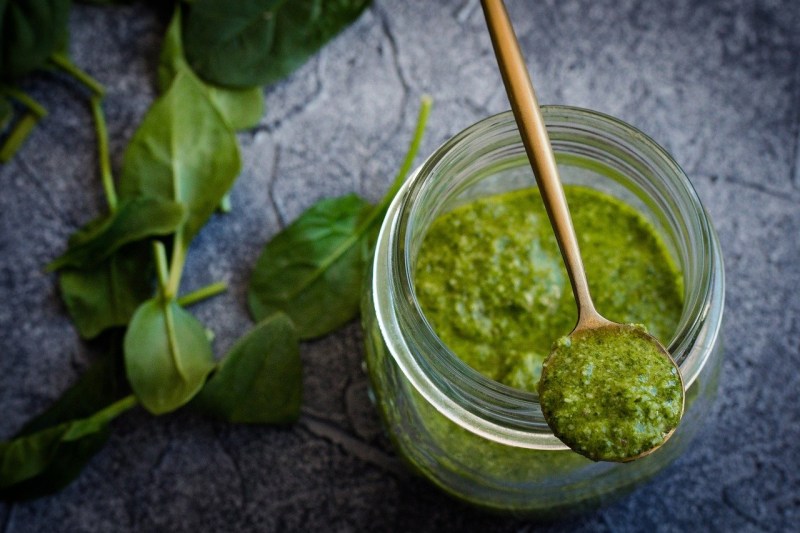Rich, herby, bright, and incredibly flavorful, pesto is one of the world’s most popular sauces. The beautiful green mixture is the perfect accent to so many dishes, from just about every pasta dish imaginable, to steak to seafood. It also shines bright on its own, spread generously on a warm baguette, its gorgeous green color taking center stage even before the first bite. Mix a spoonful into soup for an instant upgrade. Stir a bit into mayonnaise for a deliciously earthy sandwich spread. Substitute your red sauce for a vivacious green the next time you make a pizza. The possibilities are endless, and too often, this wonderfully versatile ingredient gets labeled as nothing more than a pasta sauce. It’s time to rebel.
Pesto was invented in Genoa, Italy, appearing for the first time in the mid-19th century. The lineage of this fragrant green sauce can be traced to an ancient Roman version called moretum, a dip made from herbs, cheese, garlic, and olive oil. The name pesto is Genovese, meaning “to pound” or “to crush.” The Genovese are intensely proud of their invention. For the pesto connoisseur in Genoa, true pesto can only exist in its birthplace, made with the original ingredients of basil, cheese (Parmigiano Reggiano or pecorino sardo), pine nuts, garlic, and olive oil.
Because pesto is now global, the sauce has acclimated itself to the flavors of different cultures and countries. Peruvian pesto, introduced to the country by Italian immigrants, is made with spinach and walnuts. In southern France, a version without nuts called pistou is popular. Even in Italy, different versions of pesto exists, such as Sicilian pesto alla trapanese, which includes tomatoes combined with traditional pesto ingredients.
These days, pesto is often made with a food processor. This a great replacement for the modern cook, as the result will still be delicious while also saving time. For a more traditional version, though, try preparing pesto in a mortar and pestle. This process creates a completely different texture and flavor. Blending the sauce produces emulsification, resulting in a smooth sauce. By using a mortar and pestle, the pieces of the individual ingredients will remain separate, allowing the ability to taste the separate flavors rather than a smooth, blended paste. For the best pesto, use only small, young basil leaves.
Pesto Recipe

Traditionally, pesto is a mixture of basil leaves, pine nuts, Parmesan, garlic, and olive oil. There is no denying that this version is delicious, and is one of the most popular sauces in the world for good reason. However, as with most sauces, when making your own, feel free to tweak tradition a bit. In our experience, we’ve found that pistachios make for a beautiful substitution to pine nuts, contributing to the gorgeous green color, and rounding out the overall flavor with their milder, sweeter notes. The addition of artichokes provides a sweet and earthy flavor, and a velvety texture to an otherwise rather grainy sauce.
Though our recipe is a slightly less-than-traditional take, you’re welcome to substitute pine nuts for pistachios, and eliminate the artichoke hearts. But we think these changes really amp up the flavor and improve an already incredible sauce.
Yield: Makes about 1 cup
Ingredients:
- 2 cups fresh basil leaves, stems removed
- 2 cloves garlic
- 1/2 cup pistachios, shelled
- 1/4 cup Parmesan cheese, grated
- 4 ounces marinated artichoke hearts, roughly chopped
- Juice from 1/2 lemon
- 1/2 cup extra-virgin olive oil
- 1/2 tablespoon white wine vinegar
- Kosher salt
- Freshly ground black pepper
Method:
- In a food processor, combine all ingredients except oil
- While food processor is running, slowly drizzle in olive oil until pesto is smooth
- That’s it. That’s how easy it actually is.



